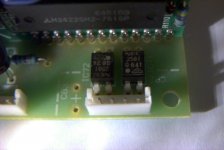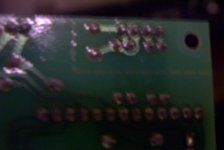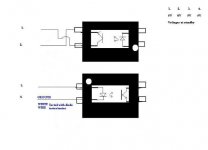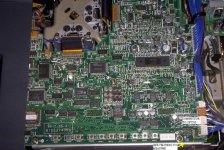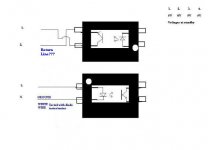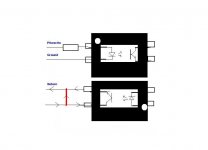Help with optos, please.
TUGA, ARE YOU THERE??!?!
I've followed this thread to the extent of my posibilities. I could use some help now.
I've found the optos, and identified one cable as ground but, when measuring voltage between this "ground" and the ground marked at the mainboard (see pic. 4) I get 5V....I'm confused.
All voltages are the same at Standby, Startup (when I press the power button) and after the Lamp Led starts flashing (signaling it has detected no lamp).
HELP!!!!
Andres
TUGA, ARE YOU THERE??!?!
I've followed this thread to the extent of my posibilities. I could use some help now.
I've found the optos, and identified one cable as ground but, when measuring voltage between this "ground" and the ground marked at the mainboard (see pic. 4) I get 5V....I'm confused.
All voltages are the same at Standby, Startup (when I press the power button) and after the Lamp Led starts flashing (signaling it has detected no lamp).
HELP!!!!
Andres
Attachments
I dont know if I got this right... could it be that I have to pull line 2 (in my diagram) to 5V? This seems to be the return line, right?
If anyone knows please reply, otherwise I'm gonna have to try anyways and I dont feel like blowing any parts of my projector up.
Thanks.
If anyone knows please reply, otherwise I'm gonna have to try anyways and I dont feel like blowing any parts of my projector up.
Thanks.
Attachments
If you look at my pictures, they look very much like yours but the optocouplers are switched I think. The one you are looking for (the one that tells the mainboard when the lamp is on) is the bottom one, or the right one if you are looking from the connector.
You need to bypass that optocupler. Look at the drawing. If you do that, that circuit is ALWAYS going to be closed and so the mainboard will get the "OK" signal all the time.
I used a paper clip on the connector to do this. You have to be certain which wire from the connector goes to which of the four "ends" of the optocouplers to do this.
Ask again if its not clear enough.
You need to bypass that optocupler. Look at the drawing. If you do that, that circuit is ALWAYS going to be closed and so the mainboard will get the "OK" signal all the time.
I used a paper clip on the connector to do this. You have to be certain which wire from the connector goes to which of the four "ends" of the optocouplers to do this.
Ask again if its not clear enough.
Attachments
Hi,
Sorry for not replying but was away on a fishing trip.
I'm glad that the info on using optos was useful to someone else!!
Well done! now you only need to build a light engine small enough to fit in the projector.
I still don’t have the lamp.
You might find that you can remove some bits out of the power supply side.
In my case a whole PCB, it will give me room to fit the ballast and ignitor inside the projector. Once is finished you wont be able to see the difference from the outside. Hopefully.
 but be careful with the HIGH VOLTAGES.
but be careful with the HIGH VOLTAGES. 
Always work on it switched off.
Also remember that capacitors can store enough to give you a nasty electric shock even several hours after you have switched the power off.

Sorry for not replying but was away on a fishing trip.
I'm glad that the info on using optos was useful to someone else!!
Well done! now you only need to build a light engine small enough to fit in the projector.
I still don’t have the lamp.

You might find that you can remove some bits out of the power supply side.
In my case a whole PCB, it will give me room to fit the ballast and ignitor inside the projector. Once is finished you wont be able to see the difference from the outside. Hopefully.
 but be careful with the HIGH VOLTAGES.
but be careful with the HIGH VOLTAGES. 
Always work on it switched off.
Also remember that capacitors can store enough to give you a nasty electric shock even several hours after you have switched the power off.


Hi Tuga,
Following what you had done I also removed the whole PCB with the optos with great success!!
If I remove a steel box (with a glass window) where the lamp used to be I now have a space thats roughly 5"x5" by 7" deep. I hope this is enough for the lamp at least. I might not mind putting the ballast on the outside.
I've been looking into the light engine situation for a few days and I havent been able to figure out if I can get a lamp+reflector thats gonna give me a beam thats parallel enough. I might need to add a condenser lens to the setup, which will increase the size of the light engine.
What are your thoughts on this?
Following what you had done I also removed the whole PCB with the optos with great success!!
If I remove a steel box (with a glass window) where the lamp used to be I now have a space thats roughly 5"x5" by 7" deep. I hope this is enough for the lamp at least. I might not mind putting the ballast on the outside.
I've been looking into the light engine situation for a few days and I havent been able to figure out if I can get a lamp+reflector thats gonna give me a beam thats parallel enough. I might need to add a condenser lens to the setup, which will increase the size of the light engine.
What are your thoughts on this?
Hi,
That I would also like to know….lol.
I tried with a dichroic halogen bulb 250w with a external PSU (to big about 600W)
And the picture was acceptable, but I had a IR filter right next to it and the bulb didn’t like it and died after 10mins...
I will try fitting an Osram HQI-T (85mm long) to a par20 reflector and see how it goes.
I have not tried any optics or light engine set up yet so I am not the best person to ask.
I think the ones who can help you /me on this are, Mathias, Ace and Tiarb. (no disrespect to all other great minds on this forum)
Tiarb as done it and tried a few options so make a search for posts from Tiarb.
There is really useful info on them about retrofitting.
I still have to wait a few weeks before I can order the da** lamp.
Please let us know how it goes…
PS: Slickwillie, U don’t know how RELIEVED I am to ear from you again….lol
That I would also like to know….lol.
I tried with a dichroic halogen bulb 250w with a external PSU (to big about 600W)
And the picture was acceptable, but I had a IR filter right next to it and the bulb didn’t like it and died after 10mins...
I will try fitting an Osram HQI-T (85mm long) to a par20 reflector and see how it goes.
I have not tried any optics or light engine set up yet so I am not the best person to ask.
I think the ones who can help you /me on this are, Mathias, Ace and Tiarb. (no disrespect to all other great minds on this forum)
Tiarb as done it and tried a few options so make a search for posts from Tiarb.
There is really useful info on them about retrofitting.
I still have to wait a few weeks before I can order the da** lamp.
Please let us know how it goes…
PS: Slickwillie, U don’t know how RELIEVED I am to ear from you again….lol

FOR SALE
I have a light, a ballast and a socket for sale, its a brand new 400 Watt Metal Halide bulb, socket and ballast, I have an extra one from a project I was going to try with two bulbs, its never even been used, BRAND NEW!
I still have the reciept for it all at 182.34 CDN, its all high quality low-noise stuff, I want 150.00 CDN for it all, make me an offer if you don't think thats reasonable.
Let Me know at this email address: j_osborne@unitz.ca
Thanks.
I have a light, a ballast and a socket for sale, its a brand new 400 Watt Metal Halide bulb, socket and ballast, I have an extra one from a project I was going to try with two bulbs, its never even been used, BRAND NEW!
I still have the reciept for it all at 182.34 CDN, its all high quality low-noise stuff, I want 150.00 CDN for it all, make me an offer if you don't think thats reasonable.
Let Me know at this email address: j_osborne@unitz.ca
Thanks.
This setups look very promissing (although I dont think they are cheap)
http://www.peclamp.com/new_ntp.htm
http://www.peclamp.com/new_shp.htm
I've contacted this company to try and get a price quote. Look at he color temp, 8500k for the SHP mercury and 6000k for the MH.
http://www.peclamp.com/new_ntp.htm
http://www.peclamp.com/new_shp.htm
I've contacted this company to try and get a price quote. Look at he color temp, 8500k for the SHP mercury and 6000k for the MH.
Lam\ps and replacements
To answer some the questions that have apperaed on this forum and give my bit of info:
Firstly, the reason that the MH and UHP lamps have a small electrode gap is so that the light can be spread evenly by the lamp reflector over the required area. All that does is provide an almost parrallel light source through the rest of the optics to the LCD screens.
So there is nothing magic in using a point light source and no reason why any other light source cannot be used.
The difficulty is obtaining an even light spread of a constant light temperature.
Secondly, I have been using street light MH inner lamps in one of my projectors for several years now. These are quite cheap to purchase and have an expected life of 10000 hours, but, they do have their own problems. Most are AC types and so the electrodes are equal in size.. If you are going to use them on DC then you will have two problems - one, one electrode will overheat - two, there will be problems with chemical reations at the hot electrode. I f your projector has a DC supply for the lamp, it is better to obtain the DC types in which one electrode is much larger than the other.
For every one that I have tried, I have carefully broken the large outer glass cover and removed the inner quartz bulb. Using linen gloves to handle it, I have then glued it in place in the glass reflector of an old projector lamp, using muffler cement. The correct location to give a fairly even light output can be seen from the front by looking at the image in the reflector surface. It must be evenly looking at the electrode gap.
There will probably be some extra leakage light from the rear of the centre of the lamp holder so make sure that you use enough muffler cement back there to block this.
Now without the outer protective glass envelope the lamp will output a lot of UV. So be careful and do not look at any leakage light when it is use. Also make sure that you UV filter between the lamp and the LCD screens is in good condition. Otherwise you LCD screens will gradually deteriorate.
Thirdly, regarding the ballasts for the lamps: all have current limiting device in them since all of these HID lamps are inherently negative resistance types. SO you will not overload the ballast from a current point of view. But, and this is important, different types of thes lamps have different gases in them ans os the operating voltage for the arc will be different. This is where you can overload you ballast. If the normal lamp draws 4 Amps at 30 Volts across the lamp then that is what the ballast has been designed to accomodate. But if the replacement lamp has more or less voltage across the arc when running then you can either overload the lamp or the ballast.
In addition, the high voltage need to get the lamp to start arcing in the first place will depend on the gases used as well as the electrode construction. Some lamps will not strike because this voltage is too low. Now many street lamps have an extra electrode to asssit in lowing this striking voltage. Some even had then externally wrapped around the unner bulb near to the opposite electrode.
So you have to be very careful in changing the type of lamp. But it can be done.
Forthly, the actual light output that you will get on screen will probably be a bit less than the equivalent normal lamp. This is due to the difficulty in aligning the new lamp to give full light output. There are a lot of losses along the way for older projectors wheras the later types have btter optics. In all cases though LCD screens tend to lose about half the light from the lamp.
Finally, for all those people trying to use LEDs, keep going and do not pay any attention to the negative people. I too have tried using LEDs - 100 of each of red, blue, and green - but have not had much success. The distribution of the light was too uneven and the colour temperature was not only uneven but also variable from one day to the next, even with current control to each group of colour LEDs. The light output was not as high as it needed to be and only produced an apparent light output of less than half of the normal brightness of the normal 1000 lumen lamp.
I suspect that the heat from the very closely matrixed LEDs was affecting the output of the individual LEDS. For reference they were obtained from Hong Kong via eBay and the red LEDs were advertised as "typically 20,000mcd" output.
To answer some the questions that have apperaed on this forum and give my bit of info:
Firstly, the reason that the MH and UHP lamps have a small electrode gap is so that the light can be spread evenly by the lamp reflector over the required area. All that does is provide an almost parrallel light source through the rest of the optics to the LCD screens.
So there is nothing magic in using a point light source and no reason why any other light source cannot be used.
The difficulty is obtaining an even light spread of a constant light temperature.
Secondly, I have been using street light MH inner lamps in one of my projectors for several years now. These are quite cheap to purchase and have an expected life of 10000 hours, but, they do have their own problems. Most are AC types and so the electrodes are equal in size.. If you are going to use them on DC then you will have two problems - one, one electrode will overheat - two, there will be problems with chemical reations at the hot electrode. I f your projector has a DC supply for the lamp, it is better to obtain the DC types in which one electrode is much larger than the other.
For every one that I have tried, I have carefully broken the large outer glass cover and removed the inner quartz bulb. Using linen gloves to handle it, I have then glued it in place in the glass reflector of an old projector lamp, using muffler cement. The correct location to give a fairly even light output can be seen from the front by looking at the image in the reflector surface. It must be evenly looking at the electrode gap.
There will probably be some extra leakage light from the rear of the centre of the lamp holder so make sure that you use enough muffler cement back there to block this.
Now without the outer protective glass envelope the lamp will output a lot of UV. So be careful and do not look at any leakage light when it is use. Also make sure that you UV filter between the lamp and the LCD screens is in good condition. Otherwise you LCD screens will gradually deteriorate.
Thirdly, regarding the ballasts for the lamps: all have current limiting device in them since all of these HID lamps are inherently negative resistance types. SO you will not overload the ballast from a current point of view. But, and this is important, different types of thes lamps have different gases in them ans os the operating voltage for the arc will be different. This is where you can overload you ballast. If the normal lamp draws 4 Amps at 30 Volts across the lamp then that is what the ballast has been designed to accomodate. But if the replacement lamp has more or less voltage across the arc when running then you can either overload the lamp or the ballast.
In addition, the high voltage need to get the lamp to start arcing in the first place will depend on the gases used as well as the electrode construction. Some lamps will not strike because this voltage is too low. Now many street lamps have an extra electrode to asssit in lowing this striking voltage. Some even had then externally wrapped around the unner bulb near to the opposite electrode.
So you have to be very careful in changing the type of lamp. But it can be done.
Forthly, the actual light output that you will get on screen will probably be a bit less than the equivalent normal lamp. This is due to the difficulty in aligning the new lamp to give full light output. There are a lot of losses along the way for older projectors wheras the later types have btter optics. In all cases though LCD screens tend to lose about half the light from the lamp.
Finally, for all those people trying to use LEDs, keep going and do not pay any attention to the negative people. I too have tried using LEDs - 100 of each of red, blue, and green - but have not had much success. The distribution of the light was too uneven and the colour temperature was not only uneven but also variable from one day to the next, even with current control to each group of colour LEDs. The light output was not as high as it needed to be and only produced an apparent light output of less than half of the normal brightness of the normal 1000 lumen lamp.
I suspect that the heat from the very closely matrixed LEDs was affecting the output of the individual LEDS. For reference they were obtained from Hong Kong via eBay and the red LEDs were advertised as "typically 20,000mcd" output.
18 wheelers Lamp and balast, dlp
I want to use this lamp for a dlp projector I think with the colour wheel I could get problems with interfererance with 50hz like a raster line if I use a transformer type balast. I think a high frequency or DC is needed the balast in the picture looks like a high frequency switch mode supply i think this should be ok
of course I could be totaly wrong
any ideas on this would be good
I want to use this lamp for a dlp projector I think with the colour wheel I could get problems with interfererance with 50hz like a raster line if I use a transformer type balast. I think a high frequency or DC is needed the balast in the picture looks like a high frequency switch mode supply i think this should be ok
of course I could be totaly wrong
any ideas on this would be good
hi, i have been reading this thread with great interest. i am trying to replace my projector's lamp with a cheaper one.
i thought i had worked it out, then it turns out that some (all?) projectors use uhp lamps which are dc as opposed to ac for mh!
i have two projectors which i bought off ebay very cheap- a liesegang dv290 and a 3m mp8640. they are actually the same projector marketed by the two different companies (the hitachi cp-l850w is also the same)
i bought the liesegang partly because it was cheap, and partly because it is old and big, reasoning that the older and bigger it is, the more chance i have of retrofitting the lamp successfully.
i got the 3m because it was dirt cheap (won't power up) and because if i manage to work out a lamp arrangement that works, i can just duplicate it on the other machine (cinema in the bedroom too!)
anyhoo, the user manual for these machines states that the lamp is 260w metal halide- does this mean that the lamp is definately NOT a uhp lamp, or are uhp's a type of metal halide?
i'm guessing that it's a normal metal halide lamp, as it's an old machine (presuming uhp's are the latest technology). when i take the lamp out of the reflector, i'll be able to get a good look at the electrodes- i believe they are different sizes for dc (uhp) and the same size for ac (mh) is this correct?
as far as i know, mh lamps need their rated current +/- 10%. if this is correct, a 250w lamp powered by a 260w ballast should be fine.
could anyone who knows about these things check the above and tell me if i have made any mistakes before i blow my lamp/ projector/ self up?
if i get this to work, i'll write a nice detailed description of exactly what i did and how i did it, as i can't seem to find any posts from people who have done this
i thought i had worked it out, then it turns out that some (all?) projectors use uhp lamps which are dc as opposed to ac for mh!
i have two projectors which i bought off ebay very cheap- a liesegang dv290 and a 3m mp8640. they are actually the same projector marketed by the two different companies (the hitachi cp-l850w is also the same)
i bought the liesegang partly because it was cheap, and partly because it is old and big, reasoning that the older and bigger it is, the more chance i have of retrofitting the lamp successfully.
i got the 3m because it was dirt cheap (won't power up) and because if i manage to work out a lamp arrangement that works, i can just duplicate it on the other machine (cinema in the bedroom too!)
anyhoo, the user manual for these machines states that the lamp is 260w metal halide- does this mean that the lamp is definately NOT a uhp lamp, or are uhp's a type of metal halide?
i'm guessing that it's a normal metal halide lamp, as it's an old machine (presuming uhp's are the latest technology). when i take the lamp out of the reflector, i'll be able to get a good look at the electrodes- i believe they are different sizes for dc (uhp) and the same size for ac (mh) is this correct?
as far as i know, mh lamps need their rated current +/- 10%. if this is correct, a 250w lamp powered by a 260w ballast should be fine.
could anyone who knows about these things check the above and tell me if i have made any mistakes before i blow my lamp/ projector/ self up?
if i get this to work, i'll write a nice detailed description of exactly what i did and how i did it, as i can't seem to find any posts from people who have done this
- Status
- This old topic is closed. If you want to reopen this topic, contact a moderator using the "Report Post" button.
- Home
- General Interest
- Everything Else
- The Moving Image
- Lighting and OHP
- DIY replacement lamp for projector
